吉林大学:《商务英语选读》课程电子教案(PPT课件)Unit 5 Text b Nonverbal Communication

Text B Nonverbal Communication
Text B Nonverbal Communication
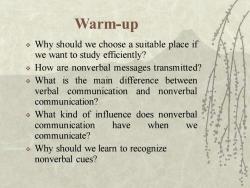
Warm-up Why should we choose a suitable place if we want to study efficiently? How are nonverbal messages transmitted? What is the main difference between verbal communication and nonverbal communication? What kind of influence does nonverbal communication have when we communicate? Why should we learn to recognize nonverbal cues?
Warm-up ❖ Why should we choose a suitable place if we want to study efficiently? ❖ How are nonverbal messages transmitted? ❖ What is the main difference between verbal communication and nonverbal communication? ❖ What kind of influence does nonverbal communication have when we communicate? ❖ Why should we learn to recognize nonverbal cues?
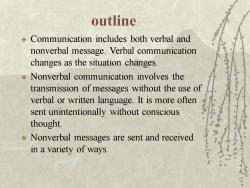
outline *Communication includes both verbal and nonverbal message.Verbal communication changes as the situation changes. Nonverbal communication involves the transmission of messages without the use of verbal or written language.It is more often sent unintentionally without conscious thought. Nonverbal messages are sent and received in a variety of ways
outline ❖ Communication includes both verbal and nonverbal message. Verbal communication changes as the situation changes. ❖ Nonverbal communication involves the transmission of messages without the use of verbal or written language. It is more often sent unintentionally without conscious thought. ❖ Nonverbal messages are sent and received in a variety of ways
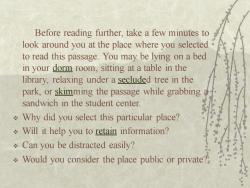
Before reading further,take a few minutes to look around you at the place where you selected to read this passage.You may be lying on a bed in your dorm room,sitting at a table in the library,relaxing under a secluded tree in the park,or skimming the passage while grabbing a sandwich in the student center. Why did you select this particular place? Will it help you to retain information? Can you be distracted easily? Would you consider the place public or private?
Before reading further, take a few minutes to look around you at the place where you selected to read this passage. You may be lying on a bed in your dorm room, sitting at a table in the library, relaxing under a secluded tree in the park, or skimming the passage while grabbing a sandwich in the student center. ❖ Why did you select this particular place? ❖ Will it help you to retain information? ❖ Can you be distracted easily? ❖ Would you consider the place public or private?
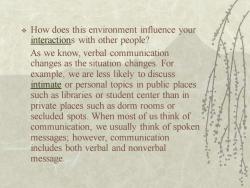
How does this environment influence your interactions with other people? As we know,verbal communication changes as the situation changes.For example,we are less likely to discuss intimate or personal topics in public places such as libraries or student center than in private places such as dorm rooms or secluded spots.When most of us think of communication,we usually think of spoken messages;however,communication includes both verbal and nonverbal message
❖ How does this environment influence your interactions with other people? As we know, verbal communication changes as the situation changes. For example, we are less likely to discuss intimate or personal topics in public places such as libraries or student center than in private places such as dorm rooms or secluded spots. When most of us think of communication, we usually think of spoken messages; however, communication includes both verbal and nonverbal message
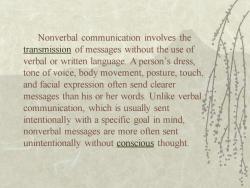
Nonverbal communication involves the transmission of messages without the use of verbal or written language.A person's dress, tone of voice,body movement,posture,touch, and facial expression often send clearer messages than his or her words.Unlike verbal communication,which is usually sent intentionally with a specific goal in mind, nonverbal messages are more often sent unintentionally without conscious thought
Nonverbal communication involves the transmission of messages without the use of verbal or written language. A person’s dress, tone of voice, body movement, posture, touch, and facial expression often send clearer messages than his or her words. Unlike verbal communication, which is usually sent intentionally with a specific goal in mind, nonverbal messages are more often sent unintentionally without conscious thought

For example,you may have been in a situation such as a job interview in which a recruiter said,"Relax,I just want to get to know you a little better,"and you wondered, "How did he know that I was anxious?" Later,you may have remembered perspiring, wringing your hands,playing with your watch,or of our outward manifestations,we can give impressions that we'd like to avoid
For example, you may have been in a situation such as a job interview in which a recruiter said, “Relax, I just want to get to know you a little better,” and you wondered, “How did he know that I was anxious?” Later, you may have remembered perspiring, wringing your hands, playing with your watch, or of our outward manifestations, we can give impressions that we’d like to avoid
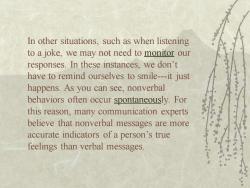
In other situations,such as when listening to a joke,we may not need to monitor our responses.In these instances,we don't have to remind ourselves to smile---it just happens.As you can see,nonverbal behaviors often occur spontaneously.For this reason,many communication experts believe that nonverbal messages are more accurate indicators of a person's true feelings than verbal messages
In other situations, such as when listening to a joke, we may not need to monitor our responses. In these instances, we don’t have to remind ourselves to smile---it just happens. As you can see, nonverbal behaviors often occur spontaneously. For this reason, many communication experts believe that nonverbal messages are more accurate indicators of a person’s true feelings than verbal messages
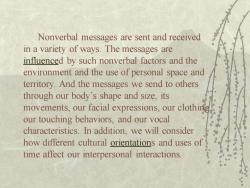
Nonverbal messages are sent and received in a variety of ways.The messages are influenced by such nonverbal factors and the environment and the use of personal space and territory.And the messages we send to others through our body's shape and size,its movements,our facial expressions,our clothing. our touching behaviors,and our vocal characteristics.In addition,we will consider how different cultural orientations and uses of time affect our interpersonal interactions
Nonverbal messages are sent and received in a variety of ways. The messages are influenced by such nonverbal factors and the environment and the use of personal space and territory. And the messages we send to others through our body’s shape and size, its movements, our facial expressions, our clothing, our touching behaviors, and our vocal characteristics. In addition, we will consider how different cultural orientations and uses of time affect our interpersonal interactions
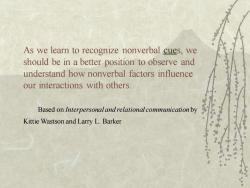
As we learn to recognize nonverbal cues,we should be in a better position to observe and understand how nonverbal factors influence our interactions with others. Based on Interpersonal and relational communication by Kittie Wastson and Larry L.Barker
As we learn to recognize nonverbal cues, we should be in a better position to observe and understand how nonverbal factors influence our interactions with others. Based on Interpersonal and relational communication by Kittie Wastson and Larry L. Barker
按次数下载不扣除下载券;
注册用户24小时内重复下载只扣除一次;
顺序:VIP每日次数-->可用次数-->下载券;
- 吉林大学:《商务英语选读》课程电子教案(PPT课件)Unit 5 Text a Oral Presentation.ppt
- 吉林大学:《商务英语选读》课程电子教案(PPT课件)Unit 4 Text c How to Argue.ppt
- 吉林大学:《商务英语选读》课程电子教案(PPT课件)Unit 4 Text b Sharpening Your Basic Skills.ppt
- 吉林大学:《商务英语选读》课程电子教案(PPT课件)Unit 4 Text a Suggestions for Effective Listening.ppt
- 吉林大学:《商务英语选读》课程电子教案(PPT课件)Unit 3 Text c The Importance of Listening.ppt
- 吉林大学:《商务英语选读》课程电子教案(PPT课件)Unit 3 Text b How Can You Develop Effective Communication Skills?.ppt
- 吉林大学:《商务英语选读》课程电子教案(PPT课件)Unit 3 Text a Functions of On-the-job Communication.ppt
- 吉林大学:《商务英语选读》课程电子教案(PPT课件)Unit 2 Text c Levels of Communication.ppt
- 吉林大学:《商务英语选读》课程电子教案(PPT课件)Unit 2 Text b How to Start a Conversation in Britain.ppt
- 吉林大学:《商务英语选读》课程电子教案(PPT课件)Unit 2 Text a How to Be Entertained.ppt
- 吉林大学:《商务英语选读》课程电子教案(PPT课件)Unit 1 Text c Gift Giving.ppt
- 吉林大学:《商务英语选读》课程电子教案(PPT课件)Unit 1 Text b Handshake.ppt
- 吉林大学:《商务英语选读》课程电子教案(PPT课件)Unit 1 Text a Etiquette and Protocol in Business(主讲人:景超).ppt
- 吉林大学:《综合英语精读》课程PPT教学课件(四)Book 4 lesson 3 SOLVE THAT PROBLEM - WITH HUMOR.ppt
- 吉林大学:《综合英语精读》课程PPT教学课件(四)Book 4 lesson 2 A Dill Pickle.ppt
- 吉林大学:《综合英语精读》课程PPT教学课件(四)Book 4 lesson 1 The Pleasure of learning.ppt
- 吉林大学:《综合英语精读》课程PPT教学课件(三)lesson 17 Multinational Corporations.ppt
- 吉林大学:《综合英语精读》课程PPT教学课件(三)lesson 16 The Oyster and the Pearl.ppt
- 吉林大学:《综合英语精读》课程PPT教学课件(三)lesson 15 A Horseman in the Sky.ppt
- 吉林大学:《综合英语精读》课程PPT教学课件(三)lesson 14 The Odour of Cheese.ppt
- 吉林大学:《商务英语选读》课程电子教案(PPT课件)Unit 5 Text c Good Body Language Is Part of Good Communication.ppt
- 吉林大学:《商务英语选读》课程电子教案(PPT课件)Unit 6 Text a How to Understand Body Language.ppt
- 吉林大学:《商务英语选读》课程电子教案(PPT课件)Unit 6 Text b Business Communication.ppt
- 吉林大学:《商务英语选读》课程电子教案(PPT课件)Unit 6 Text c Culture and Communication.ppt
- 吉林大学:《商务英语选读》课程电子教案(PPT课件)Unit 7 Text a Barrier to International communication.ppt
- 吉林大学:《商务英语选读》课程电子教案(PPT课件)Unit 7 Text b Written Communication.ppt
- 吉林大学:《商务英语选读》课程电子教案(PPT课件)Unit 7 Text c Cultural Differences.ppt
- 吉林大学:《商务英语选读》课程电子教案(PPT课件)Unit 8 Text a Guides to Good Intercultural Communication.ppt
- 吉林大学:《商务英语选读》课程电子教案(PPT课件)Unit 8 Text b Case Study - Communication Skills.ppt
- 吉林大学:《商务英语选读》课程电子教案(PPT课件)Unit 8 Text c Case Study - Oral Communication.ppt
- 吉林大学:《大学英语泛读》课程PPT教学课件(book 3)Unit 1 Reading for A’s.ppt
- 吉林大学:《大学英语泛读》课程PPT教学课件(book 3)Unit 2 Why Not Speed Up Your Reading?.ppt
- 吉林大学:《大学英语泛读》课程PPT教学课件(book 3)Unit 3 Romantic Roundabout.ppt
- 吉林大学:《大学英语泛读》课程PPT教学课件(book 3)Unit 4 The Lucky Archaeologist.ppt
- 吉林大学:《大学英语泛读》课程PPT教学课件(book 3)Unit 5 News of the Engagement.ppt
- 吉林大学:《大学英语泛读》课程PPT教学课件(book 3)Unit 6 The Story of Jazz.ppt
- 吉林大学:《大学英语泛读》课程PPT教学课件(book 3)Unit 7 The Experiences of a Chinese Immigrant, 1880-1903.ppt
- 吉林大学:《大学英语泛读》课程PPT教学课件(book 3)Unit 8 How to Guess Your Age.ppt
- 吉林大学:《大学英语泛读》课程PPT教学课件(book 3)Unit 9 The Sixth Sense.ppt
- 吉林大学:《大学英语泛读》课程PPT教学课件(book 3)Unit 10 Long Walk to Forever.ppt
